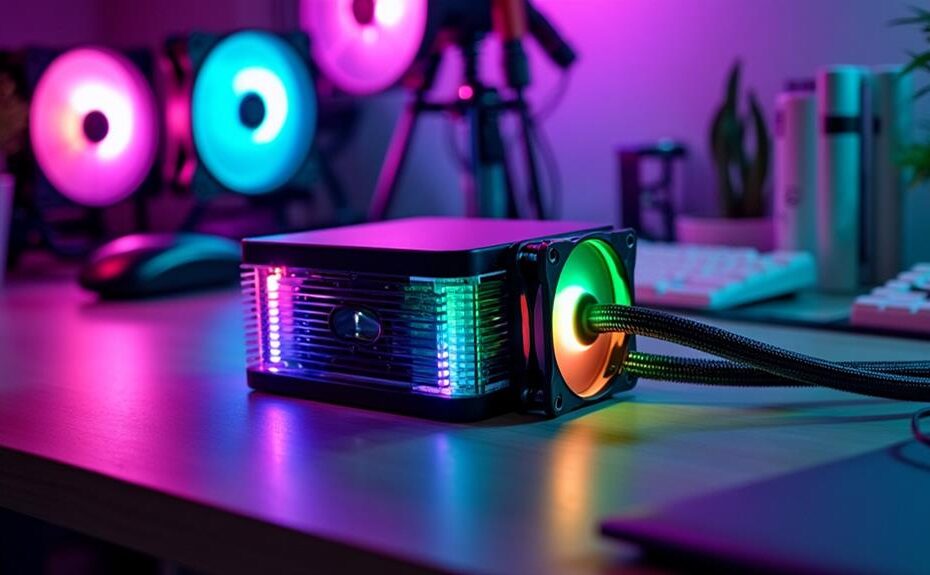



To effectively cool high-performance mini PCs, you'll need a combination of strategies tailored to manage heat efficiently. Start with proper placement in well-ventilated areas to enhance airflow. Utilize advanced ventilation structures and integrated heat sinks to optimize heat dissipation. Incorporate smart fan technology, and maintain a clean environment to prevent dust buildup. Regular maintenance checks and temperature monitoring tools can help you track performance and identify issues early. Also, consider using thermal pads and compact heat sinks. These strategies can prolong your system's lifespan while ensuring peak performance. Further insights await to enhance your cooling setup.
Key Takeaways
- Implement fanless cooling and integrated heat sinks to manage heat effectively in compact spaces.
- Maintain a clean and well-ventilated environment to prevent dust accumulation and enhance airflow.
- Utilize temperature monitoring tools to track and analyze thermal performance in real-time.
- Optimize layout by organizing components and cables to prevent airflow obstruction and promote cooling efficiency.
- Regularly clean and maintain cooling systems to ensure optimal performance and prolong the lifespan of the mini PC.
Overheating Risks
While the compact design of mini PCs offers portability and space-saving benefits, it also elevates the risk of overheating. The limited airflow in these devices can trap heat generated by high-performance components, leading to significant temperature rise. When internal parts are positioned closely together, heat accumulates rapidly, which can trigger thermal throttling. In this state, CPUs reduce their speed to prevent damage, ultimately degrading performance during demanding tasks. The high customer satisfaction associated with mini PCs like the WI-6 indicates that users appreciate the balance between performance and compactness, but it also highlights the significance of effective cooling strategies.
The powerful processors often found in high-performance mini PCs are designed to handle heavy workloads, but they produce substantial heat. Insufficient cooling systems further exacerbate overheating risks, especially if vents are blocked or airflow is poorly managed. Without effective cooling solutions, you might encounter reduced efficiency and increased likelihood of hardware failure.
Monitoring temperature is essential to avoid these pitfalls. Implementing strategies to enhance airflow and guarantee effective cooling can prolong the lifespan of your mini PC and maintain peak performance. By understanding these overheating risks, you can take proactive measures to create a more efficient and reliable computing environment, safeguarding your investment against potential thermal damage.
Cooling Design Features
Cooling design features are essential in maintaining the performance and longevity of high-performance mini PCs. These systems often utilize fanless cooling designs, which efficiently transfer heat from the processor to the casing. By doing so, they keep operating temperatures stable without introducing the noise typically associated with traditional fans. Advanced ventilation structures are crucial; they promote optimal airflow, preventing heat buildup and enhancing overall cooling performance. For instance, the cooling system designed in the Blackview 2024 Mini PC guarantees minimal performance impact during intensive tasks, showcasing the significance of effective thermal management.
In many mini PCs, integrated heat sinks play a critical role in heat dissipation, enabling effective thermal management even in compact spaces. The use of thermal pads made from thermally conductive materials further enhances heat transfer from key components to these heat sinks, guaranteeing effective cooling during high-performance tasks.
Some mini PCs incorporate smart fan technology, which adjusts fan speeds based on workload. This approach not only enhances cooling efficiency but also reduces energy consumption, aligning performance with power management. Overall, the combination of these features—efficient ventilation, strategic thermal pad placement, and adaptive fan speeds—creates a robust cooling solution vital for high-performance mini PCs.
Environmental Considerations
Environmental considerations play an important role in the performance and longevity of high-performance mini PCs. To guarantee ideal functionality, place your mini PC in a well-ventilated location, allowing adequate airflow around the device. This prevents vent blockage, which can greatly hinder cooling efficiency and lead to overheating. Additionally, efficient thermal management systems in mini PCs are necessary for preventing overheating during intense workloads, making proper ventilation even more essential. You should also monitor environmental factors such as ambient temperature and humidity, as they are critical to thermal regulation. Elevated temperatures can exacerbate the risks of overheating, so avoid exposing your mini PC to direct sunlight.
Additionally, maintaining a clean environment is necessary. Dust and debris can accumulate around the mini PC, obstructing airflow and creating hotspots that negatively impact internal components. Regularly check and clean the area to promote effective cooling.
Maintenance Practices
Regular maintenance practices are essential for guaranteeing the ideal performance and longevity of high-performance mini PCs. One of the most important aspects is regular cleaning. Dust accumulation can considerably impede airflow, which in turn affects cooling performance. You should use compressed air or a soft brush to remove dust from both the casing and internal components, helping to maintain optimal temperatures and prevent overheating.
Scheduled maintenance checks every few months are also crucial. During these checks, you can inspect fans and vents to verify they're functioning properly. Keeping the vents clear and free from obstructions is essential for effective heat dissipation; blocked airflow channels can lead to serious overheating issues.
Additionally, documenting temperature readings during maintenance can be advantageous. By tracking these readings, you can identify performance trends and spot any persistent overheating problems that may require further intervention. Adopting these maintenance practices not only enhances your mini PC's cooling performance but also extends its overall lifespan, guaranteeing that your investment remains reliable and efficient for years to come.
Usage Optimization
Optimizing usage can greatly enhance the cooling efficiency of high-performance mini PCs. By closing unnecessary applications, you can considerably reduce CPU and memory load, which helps keep temperatures in check during operation. Implementing scheduled breaks or limiting the duration of high-load tasks prevents prolonged overheating, guaranteeing your device maintains peak performance.
Utilizing performance monitoring tools allows you to identify stress points in your system. With these insights, you can adjust your usage patterns to minimize heat generation effectively. Regularly updating your software and operating systems is another vital step; it guarantees that your mini PC runs efficiently, reducing unnecessary resource usage that can lead to overheating.
Cleaning Techniques
To maintain ideal cooling efficiency in high-performance mini PCs, it's important to prioritize cleaning techniques on a routine basis. Regular cleaning prevents dust accumulation, which can greatly hinder thermal performance and lead to overheating. By using compressed air or a soft brush, you can gently remove dust from vents, fans, and heat sinks, guaranteeing unobstructed airflow.
Pay particular attention to the fan and radiator, as cleaning these components regularly is fundamental for maintaining efficient heat dissipation. High-performance components generate considerable heat, and any blockages can elevate operating temperatures and reduce the longevity of your hardware. Scheduling maintenance checks can help you identify potential cooling issues early, allowing for timely interventions that prevent thermal throttling or hardware damage.
Keeping air vents clear and free of debris is critical for peak performance. When airflow channels are blocked, it can result in increased temperatures, which negatively affects overall system stability. By consistently applying effective cleaning techniques, you make sure that your mini PC remains cool and operates efficiently, maximizing its performance and lifespan.
Layout Optimization
Routine cleaning techniques are foundational for maintaining cooling efficiency, but layout optimization is equally important. To enhance your Mini PC's cooling performance, guarantee it's placed in a well-ventilated area, away from walls and other obstacles. This arrangement prevents airflow blockage, allowing for effective air circulation and heat dissipation. Direct sunlight exposure can considerably raise temperatures, so keep your Mini PC out of bright, sunny spots to avoid unnecessary overheating.
Additionally, consider utilizing elevated stands or mounts for your Mini PC. Elevation improves airflow beneath the device, further aiding in heat dissipation. It's also essential to monitor your setup regularly; maintaining a clean environment helps prevent dust accumulation, which can obstruct airflow and negatively impact cooling performance.
Additional Cooling Solutions
When you're pushing your Mini PC to its limits, incorporating additional cooling solutions becomes vital for maintaining performance and stability. One effective strategy is to utilize third-party compact heat sinks designed specifically for small cases. These heat sinks can greatly enhance heat dissipation, effectively managing additional heat generated during demanding tasks without increasing noise levels.
For even better results, consider integrating high thermal conductivity thermal pads. These pads improve heat transfer between components and heatsinks, ensuring ideal thermal management in tight spaces. If your Mini PC is primarily used for gaming or intensive computational tasks, liquid cooling systems are a superior option. Known for their efficient heat transfer capabilities, these systems provide powerful cooling without consuming excessive space.
Regular upgrades of cooling systems based on your performance needs are essential. This proactive approach can prevent overheating, prolong hardware lifespan, and enhance overall system stability during high-demand scenarios. By combining these additional cooling solutions, you can greatly improve your Mini PC's thermal management, ensuring it runs smoothly and efficiently even under pressure.
Temperature Monitoring Tools
Monitoring temperatures is essential for maintaining the performance and longevity of your Mini PC. Utilizing temperature monitoring tools like HWMonitor and SpeedFan allows you to track CPU and GPU temperatures in real-time, helping you identify potential overheating issues early. By logging historical data, these tools enable you to analyze temperature trends over time, providing insight into how your Mini PC performs under varying loads.
You can set specific temperature thresholds within these applications to receive alerts when components exceed safe operating temperatures, prompting you to intervene before damage occurs. Some advanced monitoring software even adjusts fan speeds automatically based on temperature readings, enhancing cooling efficiency without needing your input.
With user-friendly interfaces, temperature monitoring tools display statistics in graphical formats, making it easy to assess the health of your Mini PC's cooling system at a glance. By integrating these tools into your maintenance routine, you can proactively manage overheating issues, ensuring peak performance and longevity for your high-performance Mini PC. This proactive approach not only protects your investment but also enhances your overall computing experience.
Disclosure: As an Amazon Associate, I earn from qualifying purchases.






